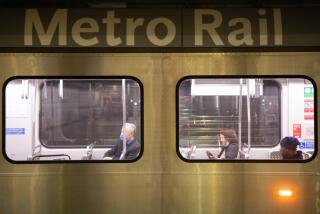In Subway Crime, N.Y. Still Leads the World
- Share via
The subway mugger, that all-American symbol of crime beneath city streets, is now spreading fear through “metro” systems around the world.
But even in Paris, where the French are talking about calling in the army to control subway gangs, the transit system’s crime rate still falls far short of New York’s 14,000 underground felonies a year.
An Associated Press check of cities on four continents found that some subway systems are almost crime-free--because of relatively small size, limited times of operation, heavily middle-class ridership and new designs that make them easier to patrol.
And sometimes, as in Japan, the subways are safe because the society is safe.
When a Tokyo youth punched an elderly subway rider in the face two months ago, he touched off a national furor. This breach of Japanese decorum was described by police as the first “serious crime” in 10 years aboard Tokyo’s jam-packed underground system.
Avoid Troubling Others
Japanese subway passengers “take care not to trouble others,” explained transit system official Shoichi Tanaka.
In other cities, however, subway assaults and robberies are a major and growing concern, a fear expressed in newspaper headlines and at dinner conversations, just as it has been in the United States in the aftermath of New York’s highly publicized “subway vigilante” episode, in which a passenger shot four alleged muggers.
In the Brazilian metropolis of Sao Paulo, for example, the subway crime rate has increased fivefold over the past five years, while annual ridership doubled to 409 million.
The system’s chief manager, Isidoro Teles de Souza, has an explanation: The subway was extended into low-income, high-crime areas.
“So it attracts more petty criminals,” he said. “Also, the subway’s own security forces (415 men) have not increased with the rising ridership.”
‘Vigilantes’ on Buses
Rio de Janeiro has commuter “vigilantes,” but they ride the buses, not the subway.
Rio’s six-year-old, 18-mile subway system serves mostly middle-income areas. The poor people take the bus, and shootouts occur regularly between muggers and gun-toting passengers--not surprising in a country where tens of thousands of citizens have armed themselves for protection against criminals.
The recommendation that soldiers be put in the Paris Metro was made last month by a special transit authority panel that studied rising crime in the underground railway.
The number of reported robberies and other attacks on the Paris subway rose from 803 in 1980 to 4,101 in 1984, the authority says.
Transit authority spokesman Jacques Barrot attributes the increase to “a new phenomenon--organized gangs carrying out purse- and jewel-snatching, with a network of receivers to get rid of the jewelry, in particular.”
New Youth Patrol
Expansion of the Metro security force--from 430 in 1980 to 630 today--has not kept pace with the upsurge in crime, although the transit authority this month will hire 800 out-of-work youths as an auxiliary patrol force.
But the Paris subway crime rate--one attack per 575,000 riders--still is only one-eighth New York’s frequency of one attack per 71,000 riders.
“New York is unique,” said Ed Silberfarb, a spokesman for that city’s transit police. “There are few systems of its size and complexity. And the New York subway may be the only one of any size that operates 24 hours a day.”
The Paris subway, only half the size of New York’s 200-mile system, shuts down between 1 a.m. and 5 a.m.
Crime specialists also note that the New York subway’s antique design, full of nooks, pillars, long corridors and blind corners, is more hospitable to criminals than are the newer subways of such cities as Washington, D.C., which are designed for clear sightlines, television monitoring and safety.
Decline in Felonies
Despite the negative publicity, New York transit officials point out that reported felonies, which leaped from 12,908 in 1980 to 15,295 in 1981, have declined slightly since then. They credit a 40% increase in transit policemen, to 3,800, since 1980.
Here is a look at some other subway systems:
- The 122-year-old London Underground, the world’s first subway, is comparable to New York’s in size and in total reported crimes--about 10,000 a year. But most are pickpocketing offenses.
One revealing statistic: The London “Tube” had fewer than 600 reported robberies in 1984, compared with 5,999 in the New York subway.
“The lack of crime reflects what’s going on in the streets, and, generally speaking, it’s pretty safe on the streets of London,” said Underground spokesman Ken Cordner.
- Rome’s 15-mile, two-line subway system, most of which was completed only five years ago, experienced its first major crime Feb. 8, the firebombing of an empty car. A left-wing extremist group claimed responsibility.
- The Soviet Union publishes no crime statistics, but the 125-mile Moscow metro network, which carries 2.5 billion riders a year, compared with New York’s 1 billion, is considered practically crime-free.
Purse-snatchings, muggings and similar offenses are rare anywhere in the Soviet Union. In the subways, anyone with larceny in his heart is probably discouraged by the heavy presence of patrolling militiamen.
- Although economic hard times are driving more Mexicans to street crime, few serious crimes are reported among the 4 million riders crowding into the Mexico City metro each day.
More to Read
Sign up for Essential California
The most important California stories and recommendations in your inbox every morning.
You may occasionally receive promotional content from the Los Angeles Times.













